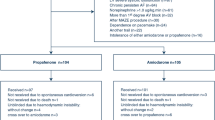Summary
INTRODUCTION: Ibutilide is an intravenous class III antiarrhythmic agent that has been shown to be effective in converting acute onset atrial fibrillation/flutter in stable medical and cardio-surgical patients. Data on its use in critically ill patients are rare. The aim of this open, non-randomized, prospective trial was to assess the potential role of ibutilide for conversion of recent onset atrial fibrillation/flutter in a mixed critically ill ICU-population. METHODS: Twenty cardiac-surgical and 17 medical patients with acute tachycardic atrial fibrillation or flutter received up to two 10-min intravenous infusions of 1.0 mg ibutilide. RESULTS: The cumulative conversion efficacy of ibutilide was 56.8% (21 of 37 patients). The mean time to termination of the arrhythmia was 17.7 ± 12.5 min (range, 4 to 45 min) after the start of the first infusion. Conversion success was significantly higher in medical compared to cardiac-surgical patients (82.4 versus 35.0%, p = 0.0063). In a multivariate binary stepwise logistic regression analysis adjusted for age, heart rate and reduced left ventricular function, cardiac surgery remained significantly associated with a lower conversion probability (RR, 0.14; 95% CI, 0.02 to 0.76; p = 0.0190). Serious, ibutilide-induced ventricular arrhythmias developed in 3/37 patients (8.1%). Two of these 3 patients had a left ventricular ejection fraction of <20%. CONCLUSION: Ibutilide is an effective treatment for conversion of acute tachycardic atrial fibrillation/flutter in critically ill patients. Higher efficacy can be expected in medical than cardiac-surgical patients. Ventricular proarrhythmia, especially in patients with severely depressed left ventricular function represents the most important limitation of ibutilide treatment.
Zusammenfassung
EINLEITUNG: Das Klasse-III-Antiarrhythmikum Ibutilid wurde bei klinisch stabilen internistischen und kardiochirurgischen Patienten erfolgreich zur Kardioversion von neu aufgetretenem Vorhofflimmern/-flattern eingesetzt. Über den Einsatz bei kritisch kranken Patienten existieren nur wenige Daten. Ziel dieser offenen, nicht randomisierten, prospektiven Studie war es, den Einsatz von Ibutilid zur primären Kardioversion von neu aufgetretenem Vorhofflimmern/-flattern bei einem gemischten Kollektiv von kritisch kranken Patienten zu untersuchen. METHODEN: Zwanzig kardiochirurgische und 17 internistische Patienten mit neu aufgetretenem Vorhofflimmern/-flattern erhielten bis zu zwei 10-minütige 1 mg Ibutilid-Infusionen. ERGEBNISSE: Insgesamt kardiovertierten 56,8% (21 von 37) aller Patienten nach der Ibutilid-Gabe in Sinusrhythmus. Die mittlere Zeit bis zur Arrhythmiebeendigung betrug 17,7 ± 12,5 min (Bereich, 4 bis 45 min) nach dem Beginn der ersten Infusion. Der Kardioversionserfolg war bei internistischen Patienten signifikant höher als bei kardiochirurgischen Patienten (82,4 gegen 35,0%, p = 0.0063). In einer multivariaten binären logistischen Regressionsanalyse angepasst für Alter, Herzfrequenz, Linksventrikelfunktion blieb Herzchirurgie mit einer signifikant geringeren Kardioversions-Wahrscheinlichkeit verbunden (RR, 0,14; 95% CI, 0,02 bis 0,76; p = 0,0190). Anhaltende ventrikuläre Tachykardien traten bei 3/37 (8,1%) der Patienten auf. Zwei dieser 3 Patienten hatten eine höhergradig reduzierte Linksventrikelfunktion (<20%). ERGEBNIS: Ibutilid kann zur primären Kardioversion von neu aufgetretenem Vorhofflimmern/-flattern bei kritisch kranken Patienten wirksam eingesetzt werden. Bei internistischen Patienten ist im Vergleich zu kardiochirurgischen Patienten mit einer höheren Kardioversionsrate zu rechnen. Der potentiell bedrohliche proarrhythmische Effekt, insbesondere bei Patienten mit reduzierter Linksventrikelfunktion, stellt die größte Einschränkung beim Einsatz von Ibutilid dar.
Similar content being viewed by others
Author information
Authors and Affiliations
Rights and permissions
About this article
Cite this article
Delle Karth, G., Schillinger, M., Geppert, A. et al. Ibutilide for rapid conversion of atrial fibrillation or flutter in a mixed critically ill patient population. Wien Klin Wochenschr 117, 92–97 (2005). https://doi.org/10.1007/s00508-004-0297-4
Received:
Accepted:
Issue Date:
DOI: https://doi.org/10.1007/s00508-004-0297-4




